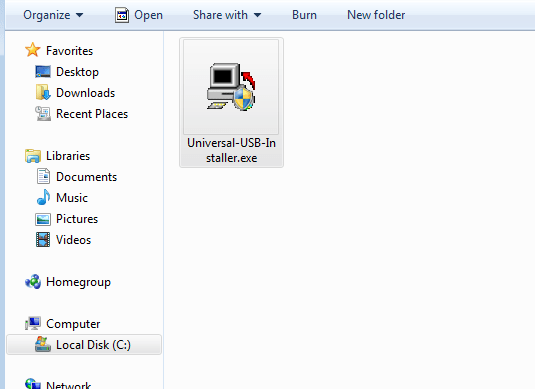In a previous post I showed how you can install a Linux distro using the VMware virtualization software. In this post we would do the same thing, but this time installing directly to the computer hard drive along side windows (7). There are some things that should be put in mind first. First make sure that you install windows 7 first, because this post follows from that premise and secondly it is easier for a new comer to Linux (and OS installation) than installing Linux first before trying to install windows 7. Secondly, it is important that you back up your files in your windows installation before you begin – just to be on a safer side. Then let the fun begin!
STEP 1
Download you desired Linux distribution. In this post I would be using Ubuntu.
STEP 2
Create a bootable disc or live USB. To create a bootable disc you can use a burning software to burn the Linux .iso file to a DVD, and then proceed to Step 3. While to create a live USB you need to have an empty (or newly formatted) USB thumb drive of at least 2GB available and then download Universal USB installer.
Plug in your thumb drive and then open or run the software and fill the appropriate fields required – they are very intuitive. 1: select the name of the Linux ditro you downloaded. 2: Select the distro .iso file in the directory you downloaded it to. 3: select you USB thumb drive you plugged in earlier. Then select “Create” and wait for some minutes, when done you would a notification.
With that done you are ready to begin the installation proper.
STEP 3
Insert the DVD containing the Ubuntu disc image or the thumb drive with the live image into your PC and reboot. You should see a welcome screen telling you to select a language and then choose if you want to try or install Ubuntu.
Alert! if this screen did not appear instead your normal windows screen, then go to your boot menu setting by restart your computer and pressing the F2 key (this might be different depending on your computer make but it’s usually the common one) when it powers on. Under you boot setting you should be able to access an area that has to do with boot sequence (that is the order in which your computer hardware components are started). If you burnt the Linux .iso to a CD/DDVD you should set your boot sequence to DVD-ROM/DRIVE, or if it is was on a USB drive you boot sequence setting should begin with the USB drive port. Then SAVE and reboot your computer again with your Linux burned media (CD/DVD/USD drive) inserted to their respective drives.
STEP 4 – installation
To begin select “install Ubuntu”. And ensure that;
-
You plug your computer to a power source (especially when you don’t have a long lasting battery)
-
Have enough disk space to install Ubuntu
-
Select “install this third-party software”
If you’re connected to the internet (it not a priority though since you could always do it later after installation) you can select “Download updates while installing”. But if not you’re good to go!
STEP 5
Setup wireless: if any wireless network is available for you to connect to you can select the particular one. Or else select “I don’t want to connect to a Wi-Fi network now” option. Then continue.
STEP 6
Installation type: choose the “Install Ubuntu alongside windows 7” option, since this is actually what we are doing. Then continue.
STEP 7
Drive Space: then choose the amount of drive space you want to allocate to ubuntu. You can do this by shifting the dividing line to either direcions to create the amount you want depending on your hard disk space. I would recommend that you give Ubuntu at least 20GB of space. Then “Install Now”.
STEP 8
Location (Time Zone): if you’re connected to the internet this would be done automatically for you. But you can manually do it, using he mouse pointer to select you location/time zone on the map or simply typing the city of your location (lagos). Then continue.
STEP 9
Keyboard layout: select your preferred language and keyboards. If you’re not sure you can use the “test your keyboard” option.
STEP10
Login Detail: then enter your personal and login details.
Then the system begins to install…
…and you could go make a cup of coffee or sit to learn a couple of stuffs about Ubuntu in the process.
Yeahh…You have successfully done it!
You can restart your computer to begin enjoying and exploring the world of Linux through the eyes of Ubuntu.
Happy Linux’NG!
- Time complexity analysis: How to calculate running time - April 1, 2024
- Sovereign Tech Fund Invests €1M In GNOME’s Open-Source Project - November 19, 2023
- Google’s Bard AI: ChatGPT Rival or The Next Frontier in AI and NLP Technology - February 8, 2023













